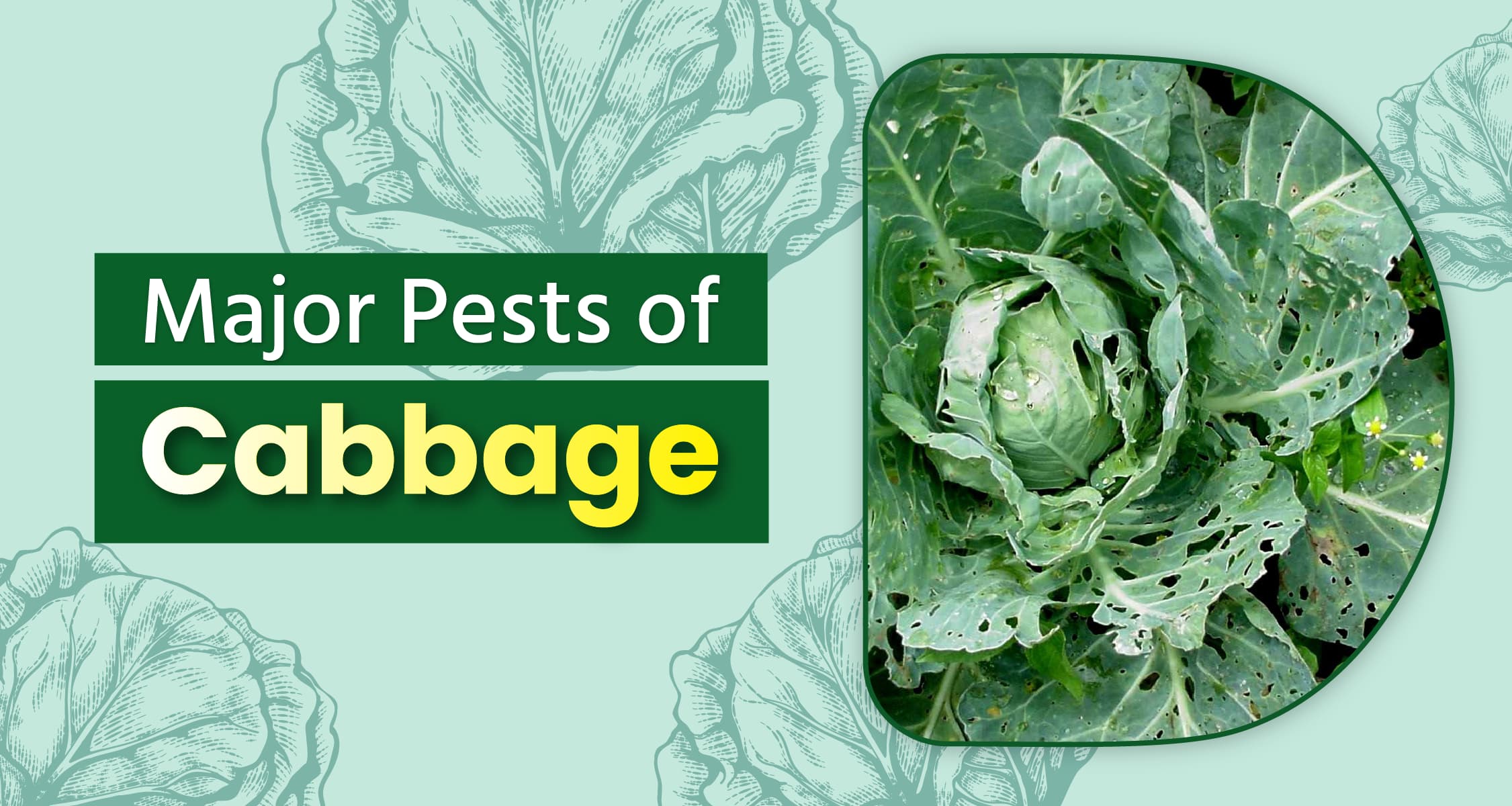तपशील
Major Pests of Cabbage

Cabbage is a popular vegetable crop. It is cultivated in Bihar, Uttar Pradesh, Odisha, West Bengal, Assam, Haryana, and Maharashtra. Although cabbage can be grown in the Rabi, Kharif, and Zaid seasons, it is most commonly planted during the Rabi season. In this post, we will through various pest problems that are frequently observed in cabbage cultivation.
How to Control Pests in Cabbage?
Aphids
- Aphids are small insects that suck the sap from tender parts of cabbage plants, such as stems, leaves, flowers, and new pods.
- After sucking the sap, these insects leave behind a liquid substance, which causes black fungus (sooty mold) to grow on the leaves.
- Due to the fungus, the leaves turn black, preventing sunlight from reaching the plant, which hinders photosynthesis. As a result, the plant cannot produce food properly, affecting both yield and quality.
Control
- Install 12 to 15 yellow sticky traps per acre.
- Spray a mixture of 2 to 5 ml neem oil in 1 liter of water.
- In case of severe aphid infestation, spray 12 to 15 grams per acre of Imidacloprid 70% WG (DeHaat Contropest) insecticide.
Diamondback Moth
- This pest lays eggs on the underside of cabbage leaves.
- Green larvae attack the leaves, creating holes by eating them.
- If not controlled in time, this pest can damage 75 to 90 percent of the crop.
Control
- Install 12 to 15 yellow sticky traps per acre in the field.
- In case of severe infestation, spray Emamectin Benzoate 5% SG (DeHaat Illigo) at the rate of 100 ml per acre.
- If the infestation is high, spray Chlorantraniliprole 18.5% SC (DeHaat Ataque) at the rate of 0.3 ml per liter of water.
Tobacco Caterpillar
- Tobacco caterpillars initially come in groups and feed on cabbage leaves, gradually spreading throughout the field.
- They eat the plants and leave behind their excreta, which can spoil the flowers.
Control
- Install 8-10 pheromone traps per acre to control new moths.
- In case of severe infestation, spray Emamectin Benzoate 5% SG (DeHaat Illigo) at the rate of 100 ml per acre.
- If the infestation is high, spray Chlorantraniliprole 18.5% SC (DeHaat Ataque) at the rate of 0.3 ml per liter of water thoroughly on the cabbage.
Biological Measures to Control Pests in Cabbage Crop
Biological Pesticides
- Biological pesticides are effective in controlling pests in cabbage crops. Bacillus thuringiensis (Bt) is a major biological pesticide that targets caterpillars. It releases toxins harmful to caterpillars but has no adverse effects on humans and animals.
Use of Natural Enemies
- Leaving natural enemies such as ladybugs, lacewings, and parasitic wasps in cabbage fields can help control pests. These insects feed on pests, thereby reducing their population.
Crop Rotation
- Crop rotation in cabbage fields is an effective technique where different crops are grown in the same field during different seasons. This helps in disrupting the life cycle of pests and reduces their population.
Trap Crops
- Some plants are strategically planted to attract pests away from the main crop. For example, planting mustard alongside cabbage can help control aphids in cabbage crops.
Pheromone Traps
- Pheromone traps use synthetic pheromones to attract and trap male insects. This method can help reduce the population of pests in cabbage crops.
Things to keep in mind while using pesticides
- Ensure there are no leaks in the pump before spraying the pesticide.
- Avoid inhaling pesticide by mouth and attempting to suck up the solution directly.
- Handle liquid pesticides carefully, ensuring they do not come into contact with any part of your body. If it happens, immediately rinse with clean water.
- Always spray pesticides in the morning or evening and ensure there is no strong wind around.
- Safely store any leftover pesticides after spraying.
- Keep chemicals away from the reach of children, the elderly, and animals.
- Do not reuse pesticide containers for any other purposes. Crush them and bury them in the ground.
- After spraying, do not allow any person or animal to enter the field.
How do you control pest infestations in your cabbage crop? Share your answer and experience with us in the comments. Follow the 'Agri Doctor' channel now for more such interesting and important information. And if you liked the post, don't forget to like it and share it with more and more farmers.
Frequently Asked Questions (FAQs)
Q: When is cabbage planted?
A: Cabbage is planted in the months of July-August and September-October for cultivation. The period from July to August is considered most suitable for planting early varieties of cabbage.
Q: How many days does it take for cabbage plants to mature?
A: Cabbage crop gets ready in 40-45 days.
Q: What diseases affect cabbage?
A: Diseases affecting cabbage crops vary according to seasons and varieties. For instance, in early cabbage crops, diseases like Alternaria leaf spot and black rot are more common. In mid-early and mid-late groups, soft rot and black rot diseases are predominant. Soft rot disease is more problematic in mid-group cabbage.
कृपया सुरू ठेवण्यासाठी लॉगिन करा

Get free advice from a crop doctor
